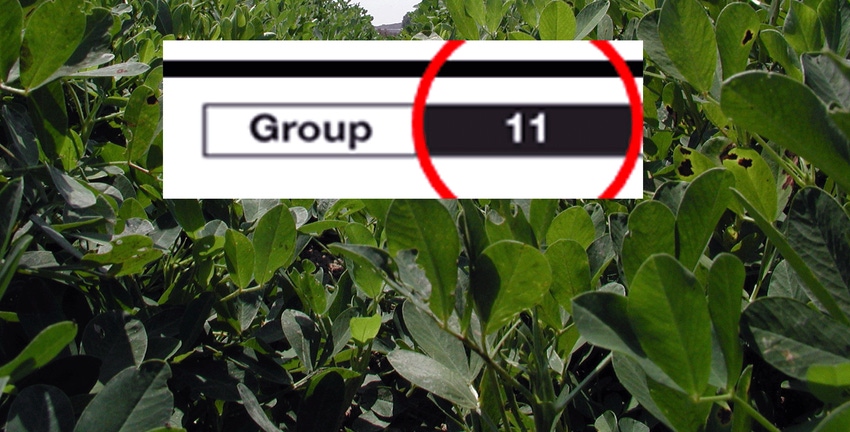
Do you look for this number on labels?
With the peanut as an example, fungicide resistance has been documented for FRAC group 1 (benzimidazoles, e.g., Benlate, leaf spot) and FRAC group 3 (tebuconazole, leaf spot). There is also significant evidence that resistance is now present in FRAC group 11 (strobulurins, leaf spot) and that efficacy may be sliding in one fungicide in FRAC group 7.
September 14, 2016

I can’t say I was surprised by Jimbo’s lack of interest, as growers too would prefer that I spend my time explaining best strategies for management of white mold or nematodes rather than discussing how to extend the lifespans and usefulness of fungicides.
After all, as some say, don’t corn, soybean, peanut and cotton growers now have a bigger arsenal of fungicides from which to choose than at any time in the past?
While true that growers have excellent fungicides for their battle against diseases, the number of different products is deceiving. Just how urgent can resistance management for tomorrow be compared to the diseases in the field today stealing yield and jeopardizing a successful harvest?
Trying to further delay completion of his homework, Jimmy looked over to me and asked, “So, Dad, what are you doing?” Anticipating that his question would spark an all-too-rare conversation, I replied, “I am writing an article on FRAC guidelines.”
“Fracking?” he said with unexpected excitement. “Isn’t that where they pump highly pressurized water into the ground to crack rocks and then collect gas and oil?”
Still hopeful, I said, “No, son, FRAC stands for ‘fungicide resistance action committee’ and the efforts of this group help farmers to continue to protect their crops from important diseases.”
Clearly disappointed, he went back to his homework unaware (and unappreciative) that FRAC is more important to the future of agriculture than fracking is to the petroleum industry. FRAC is comprised of international experts from the agrichemical community. Its major objective is to prolong the effectiveness of fungicides liable to encounter resistance problems and to limit crop losses should resistance appear.
To make this point, I encourage growers to understand the FRAC codes, numbers and/or letter combinations assigned to group active ingredients with similar modes of action (i.e., the specific target within the fungus and mechanism for killing the fungus). Fungicides with the same FRAC code are recognized for their potential for cross resistance; if a pathogen, e.g. a leaf spot-causing fungus, is able to overcome one fungicide in the group, then it can likely overcome all fungicides in the group sooner or later. Products with the same FRAC code belong to the same class of chemistry; resistance that develops to one product affects the other products bearing the same code.
Take a look at jugs or boxes of fungicides; I guarantee that many, if not most of them, belong to group 3 (to include triazoles), group 7 (to include SDHI fungicides) or group 11 (to include strobilurin fungicides). Not only are all three FRAC groups important in management of common diseases, but all are at risk to development of resistance; group 11 is at a particular high risk.
With the peanut crop as an example, fungicide resistance has been documented for FRAC group 1 (benzimidazoles, e.g., Benlate, leaf spot) and FRAC group 3 (tebuconazole, leaf spot). There is also significant evidence that resistance is now present in FRAC group 11 (strobulurins, leaf spot) and that efficacy may be sliding in one fungicide in FRAC group 7.
Once resistance develops, one of two things will happen: First, increasingly higher amounts (often beyond labeled rates) are needed to provide some level of management for a disease. Second, the fungicide, or class of fungicides, may become ineffective no matter how much is applied to the crop. It is the miss of the FRAC group, in part through development of the FRAC code, to minimize risk for fungicide resistance and to prolong efficacy of all fungicides.
Resistance to a fungicide develops for one simple reason: Repeated use of fungicides within the same class and with the same FRAC code “selects” for individuals within the pathogen population that are less sensitive. This is same process by which Palmer amaranth became resistant to glyphosate. Over time, the population of the disease-causing fungus can shift from being “highly sensitive” to a specific group of fungicides to “increasingly resistant” to them. The more specific the mode of action, as in the strobilurin fungicides, the more likely resistance is to develop. Strobilurin fungicides affect the disease-causing fungus by disrupting a very specific site in the creation of energy for the fungus. A common fungal mutation along the cytochrome b gene at location 143 can make the pathogen resistant to fungicides within FRAC group 11.
Prolonging the life of fungicides at risk to resistance begins with understanding the FRAC code. Recognizing the importance of the FRAC code and the relatedness of fungicides with the same code allows growers to make informed decisions when implementing a fungicide program. To protect at-risk fungicides from premature resistance issues requires efforts from the entire farming community; primarily growers must avoid the overuse of a fungicide. Best-management practices include rotation within a program of effective chemistries from different FRAC groups, tank-mixing fungicides from different FRAC groups, using appropriate labeled rates and by applying fungicides in a timely manner to avoid situations where disease is already well-established in a field.
FRAC codes may not be “sexy” and they may not be as interesting to my son as breaking rocks with high-pressured liquids, but they should be. Jimmy likes to eat … a LOT. Integration of the FRAC codes into a disease management program is an important step to protect the production of food and fiber.
You May Also Like



